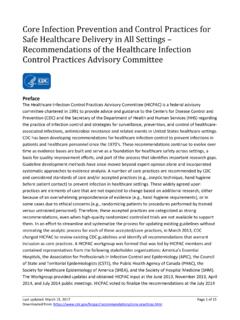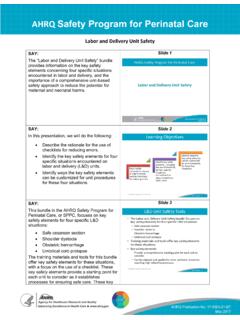Transcription of Creating and sustaining change in nursing care delivery
1 1because high nursing turnover rates strongly influence both their financial performance and the clinical outcomes they achieve. In most hospitals, nurses spend more time with patients than anyone else does, and thus they directly affect both the quality of care delivered and patient satisfaction with that care . A nursing excellence program a coordinated effort to improve the nurses work environment and give them greater professional advance-ment opportunities can achieve substantial results, as we will show. Creating sustainable change through a nursing excellence program is possible, however, only if the program aligns with the hospital or health system s nursing aspirations, targets the root causes of nurses dissatisfaction and turnover (which can vary from facility to facility, and even from unit to unit), and includes multiple mechanisms for influencing staff members to change .
2 The case for changeThe absence of a strong and stable nursing staff raises a hospital or health system s care delivery costs in a number of ways. For example, high turnover rates translate to increased recruitment and training costs. (US hospitals spend an average of about $50,000 to recruit and train each new ) Salaries must often be raised to attract new nurses. High absenteeism rates force hospitals nursing is a crucial part of healthcare delivery . In the United States, almost three million men and women currently work as registered nurses, and another 750,000 work as licensed practical nurses, making nursing by far the country s largest healthcare most hospitals and health systems have long found it challenging to maintain a strong and stable nursing staff.
3 Voluntary job turnover is much higher among nurses (about 14 per-cent annually2) than in most other occupations, in part because job satisfaction is often low. Refilling vacant positions can be quite diffi-cult and expensive. Furthermore, these prob-lems are likely to get worse in coming years because the country s need for nurses will increase considerably due to population aging and other factors. Today s US nurses have an average age of about 45 years, up to half of them expect to retire in the next 15 years, and younger nurses tend to have even higher job turnover rates than their older colleagues ,3 The reasons for nurses low job satisfaction are many, and some of them, such as the physical demands of the job, are difficult to change . However, in our healthcare work with multiple clients, we have identified a number of factors that impair nurses job satisfaction but can be corrected through a focused program.
4 Remedying these problems should be a priority for hospitals and health systems, Creating and sustaining change in nursing care deliveryBy giving nurses more control over their work environment and more opportunities for professional advancement, hospitals and health systems can reduce nurse turnover, lower costs, and improve patient Berlin, BSN, and Kurt Grote, MD1 US Bureau of Labor Statistics. Occupational Outlook Hand-book. 2012-2013 American Association of Colleges of nursing . Fact sheet on the nursing shortage. August 6, Health Research Institute. What Works: Healing the Healthcare Staffing Shortage. Sumner J, Cornett P. RN resi-dency: Seeking a new paradigm. Patient Safety Quality Health- care , March/April post-reform health system: Meeting the challenges ahead May 2013in its region, improving patient-centered or team-based care , increasing the nurses skill levels, or a combination of these goals.
5 The chosen aspiration(s) will help determine the elements that will be included in the next step is to determine the factors that have the strongest detrimental impact on nurses job satisfaction, performance, or both. Studies from around the United States (and, indeed, from around the world) have identified common concerns. For example, nurses often blame their burnout on the demanding nature of the job: its long hours, physical requirements that continue to intensify ( , lifting patients has become more difficult as obesity levels rise), and the fact that today s inpatients are much more acutely ill than inpatients a few decades ago were and thus require more care and assistance (but over a shorter length of stay). Underpayment is another frequently mentioned concern.
6 These issues are very real but often not easily solvable, especially in today s economic our work, however, we have identified a number of other factors that impair nurses job satisfaction and that are more feasible for a hospital or health system to correct. These factors include low rates of collaboration with physicians, minimal decision-making authority or control over working conditions, and an absence of training or advancement opportu-nities. At too many hospitals, for example, nurses are given only a brief initial orientation, little formal mentoring or ongoing educational opportunities (other than in-service programs), and no clear path for professional the hospital or health system has determined which factors have the greatest detrimental impact on its nursing staff, it must and health systems to rely on the use of over-time and/or agency nurses to fill staffing gaps.
7 The likelihood of nurse-sensitive problems that can increase healthcare costs, such as medication errors, falls with harm, and pres-sure ulcers, increases significantly when nurs-es are tired, unfamiliar with the units they are working in, or just burned out. Productivity often also suffers when nurses morale is our experience, a nursing excellence pro-gram can decrease voluntary turnover by up to 15 percent and lower absenteeism rates by up to 25 percent. In addition, it can mark-edly reduce the number of patient falls, medi-cation errors, and pressure ulcers. The result, for a 200-bed hospital, can be annual savings in the range of $2 million to $4 million. The cost of implementing a nursing excellence program will vary, depending on an organiza-tion s size and starting point.
8 Although many of the initiatives are relatively inexpensive to undertake, the program often requires signifi-cant initial investment to ensure that the nurses who are deeply involved in it are compensated for their time and can delegate some of their regular duties to other nurses. However, the program usually produces cost savings fairly rapidly. As a result, the program can quickly become self- sustaining and produce a deeper level of nurse engagement and ongoing im-provements in clinical a nursing excellence programAny hospital or health system that wants to undertake a nursing excellence program should begin by determining what it wants to accomplish: decreasing nursing turnover, becoming the healthcare employer of choice 3 Creating and sustaining change in nursing care deliveryas well as the experience of other healthcare organizations.
9 A mix of initiatives should be selected so that the nursing excellence program can address several of the following areas simultaneously: nurse engagement, evidence-based practice, capability building, and nurse-sensitive metrics that can gauge performance improvement (Exhibit 1). Which of these areas are most important to address will, of course, depend on the program s aspi-rations and the hospital s or health system s starting portfolio of initiatives should be fairly broad so that the program can be tailored as needed to different units; however, it should not be so large that it becomes impossible to implement. Several of the initiatives should directly address the nursing staff s top concerns; this will help drive support for the program. (For example, if one of the nurses chief complaints is lack of control over work schedules, the program should include a way to let them select more of their shifts.)
10 Support for the program can be further enhanced if the initiatives include a few quick wins things that are easy to implement and produce rapid caveat: the evidence base to support changes in nursing practice that improve job satisfaction is sometimes thin. As a result, it is not always possible to define what a best practice is. However, our experience has shown that the strategies outlined below are effective. Some of them have withstood the test of time, becoming accepted elements of established programs, such as the American Nurses Credentialing Center s Magnet Recog-nition Program (a program that rewards health- care organizations for quality patient care , nursing excellence, and innovations in profes-identify potential solutions to those problems.)



